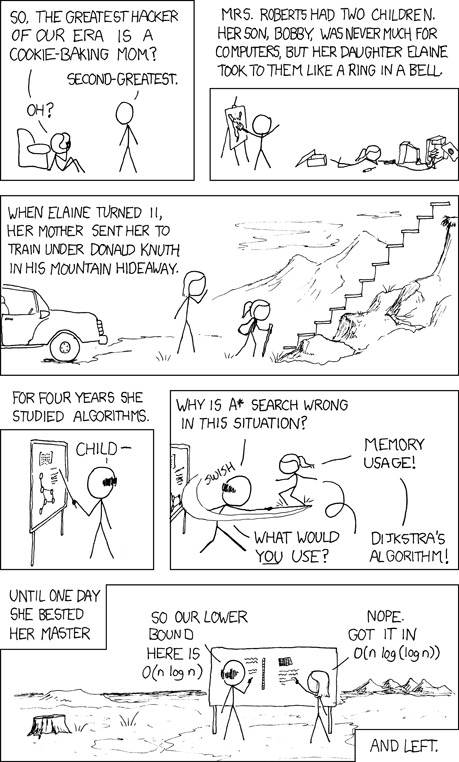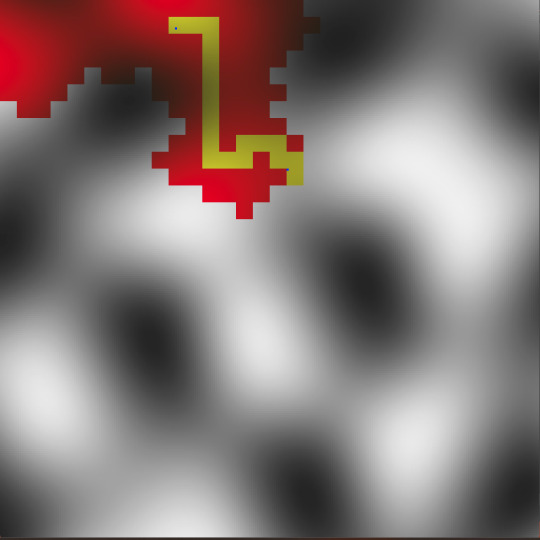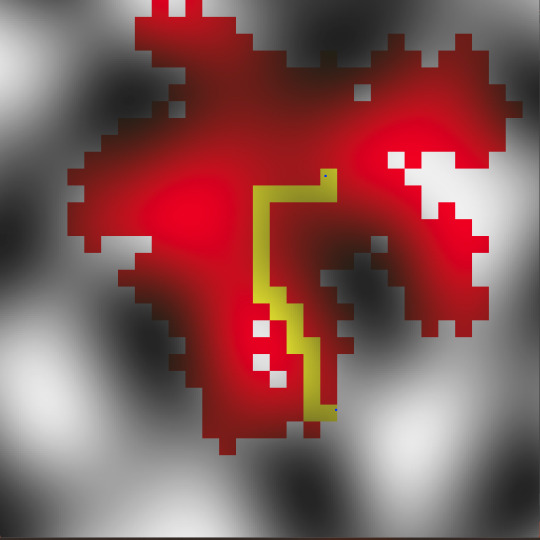#Dijkstra’s algorithm
Explore tagged Tumblr posts
Text
(white knuckling my desk while dijkstra's algorithm slinks up slowly behind me, waiting to strike) I Need To Take Pokemon Go Less Seriously
#thinking about a workflow of using ingress intel total conversion community edition (IITC-CE) and tampermonkey as well as PoGOHWH#exporting pokestop/gym data as a JSON file#importing that data back into openstreetmap and using the aformentioned dijkstra's algorithm#to find an optimal route between every pokestop/gym on my university campus#and THEN exporting all that as a shapefile and downloading it on my phone for an on-the-go reference#(all of which i am not going to do)
2 notes
·
View notes
Text
doing a "Contemporary Math for IT" class, and I gotta say
I fucking LOVE networking algorithms.
0 notes
Text
naming my lesson on Dijkstra's algorithm (pronounced dyke-stra) after an Indigo Girls song to subtly hint at my affinity for queer culture
0 notes
Text
My mother wanted my help with a spreadsheet she was working on, because asking my father had gotten her a discussion of "baseball and some Czech guy" which I slowly determined was his noting that what she had was an adjacency matrix and making dumb jokes about Lenny Dykstra and Dijkstra's algorithm. Not totally sure how she got Czech, but I solved her problem so the moral is "always ask your eldest child for help instead of your weird mathematician husband even if he's technically more knowledgeable"
#my father is certainly aware that dijkstra of algorithm fame is not Czech so plausibly she just guessed randomly#anyway if you have a math problem you've formulated appropriately my father is the most brilliant man I have ever met and it's not close#if you have lots of other normal-er types of problems he is sometimes less helpful
0 notes
Text
Artificial Intelligence at Humber College - Final Presentation
youtube
#portfolio#AI#artificial intelligence#steering behavior#steering behaviour#decision making#decision-making#decisionmaking#pathfinding#path finding#path-finding#A star#A-star#Dijkstra algorithm#breadth-first search#breadth first search#BFS#c++#computer programming#coding#code#programming#data structures
0 notes
Text
Now, you might have the common sense to realize that reading through a man page out loud is not a good use of lecture time but you're also not a PhD computer scientist making less per year than the salary of an entry-level programmer job that you dont even technically need a degree for
computer science is a very lucrative profession, the knock-on effect of which is that there are very few good computer science professors
39 notes
·
View notes
Text
drag king who always takes the shortest route betweens two points called edger w. dykestra*
*edsger w. dijkstra is the creator of dijkstra's algorithm, an algorithm used to find the shortest path between two vertices of a network
21 notes
·
View notes
Text

Trivia: Elaine is actually her middle name.
1337: Part 2 [Explained]
Transcript
[Cueball standing and looking down at his Cueball-like friend, who is sitting on the floor near an armchair holding a cloth to his face.]
Friend: So the greatest hacker of our era is a cookie-baking mom? Cueball: Second-greatest. Friend: Oh?
[Young Elaine with a ponytail on the floor typing at a keyboard while looking at a screen connected to a computer behind it with lots of wires and open case. The computer appears to have been pieced together and there is a screwdriver lying next to her and an open box lies behind her. Little Bobby Tables is painting with a broad brush at an easel to the left. There is a clear drawing with two parts going up and one down, but it's not easy to see what it should look like. He is holding his other hand up in the air, like he is enjoying the painting.] Cueball (narrating): Mrs. Roberts had two children. Her son, Bobby, was never much for computers, but her daughter Elaine took to them like a ring in a bell.
[The front of a car is in frame with side mirror and steering wheel visible. Mrs. Roberts is waving goodbye to her daughter who is wearing a backpack and is holding a walking stick. She is about to begin climbing a staircase built into a rocky mountain side. The first 11 step are visible. Behind the two and the stair are two distant mountain peaks, and above them two clouds.] Cueball (narrating): When Elaine turned 11, her mother sent her to train under Donald Knuth in his mountain hideaway.
[Donald Knuth is standing with a pointing stick at a chalk board with graph traversal patterns on it and two blocks of unreadable text the top may be a matrix.] Cueball (narrating): For four years she studied algorithms. Donald Knuth: Child—
[Donald Knuth whips around from the board slashing the stick like a sword. Elaine jumps, making a somersault and lands on the stick balancing with her arms out.] Donald Knuth: Why is A* search wrong in this situation? Stick: swish Elaine: Memory usage! Donald Knuth: What would you use? Elaine: Dijkstra's algorithm!
[Donald Knuth and Elaine are outside, seen from behind while they are both writing on a chalkboard with a thick line down the middle to separate their work. On both sides their writing can be seen but it is unreadable. Where there is only text visible on Donald Knuth's side there is also what appears to be a drawing or matrix at the top of Elaine's. But a similar thing could be behind Donald Knuth's head. Elaine is no longer wearing her hair in a ponytail but have long straight white hair like her mom, Mrs. Roberts. To the left there is a stump from a tree, some grass and maybe a puddle of water. Further back there is a small jagged hill and a flat horizon. To the right there are four mountain peaks and a flat high plateau towards the horizon. The frame of the panel does not include the top-left and bottom-right corners, but cuts round a rectangular section of both places.] Cueball (narrating): Until one day she bested her master Donald Knuth: So our lower bound here is O(n log n) Elaine: Nope. Got it in O(n log (log n)) Cueball (narrating): And left.
30 notes
·
View notes
Text


does she know I talked about her in class yesterday? dijkstra's algorithm!
6 notes
·
View notes
Text
Anyone else suffering from pathfinding algorithm favouritism? (For me it's Dijkstra's algorithm. I love it)
6 notes
·
View notes
Text



have been working on a dijkstra algorithm that connects two dots on a height map while trying to stay on the same color.
red are areas searched by the algorithm while yellow is the path already found
because the map was so large i had to divide it into chunks that were searched first. next step is to code finding the path inside the yellow chunks
5 notes
·
View notes
Text
The Algorithm a Reflection of our Life
Rhea Jean B. Science
“Computer programming is an art, because it applies accumulated knowledge to the world, because it requires skill and ingenuity, and especially because it produces objects of beauty.” – Donald Knuth.
Have you ever paused thinking how closely algorithms mirror our lives? In computer science an algorithm is simply a set of well-defined instructions. Life is that too isn't it? Every day we follow patterns just like an algorithm from waking up to going to bed.
We're running personal code if alarm rings then wake up else sleep more. In computer science we write algorithms to make machines think efficiently. We aim to do same in life - think clearly and solve challenges.
Sorting algorithms help organize data much like we try to sort priorities. Pathfinding algorithms like Dijkstra's help find the shortest path. Machine learning algorithms improve with experience and so do we. Algorithms are never perfect they require debugging and updates.
Just like in life we face errors make corrections and evolve. Let's not just build smart systems but learn from them too. Let's write better life algorithms that are ethical and adaptive. Best algorithms like best lives keep learning and improving.
Thank you.
3 notes
·
View notes
Text
Mastering Data Structures: A Comprehensive Course for Beginners
Data structures are one of the foundational concepts in computer science and software development. Mastering data structures is essential for anyone looking to pursue a career in programming, software engineering, or computer science. This article will explore the importance of a Data Structure Course, what it covers, and how it can help you excel in coding challenges and interviews.
1. What Is a Data Structure Course?
A Data Structure Course teaches students about the various ways data can be organized, stored, and manipulated efficiently. These structures are crucial for solving complex problems and optimizing the performance of applications. The course generally covers theoretical concepts along with practical applications using programming languages like C++, Java, or Python.
By the end of the course, students will gain proficiency in selecting the right data structure for different problem types, improving their problem-solving abilities.
2. Why Take a Data Structure Course?
Learning data structures is vital for both beginners and experienced developers. Here are some key reasons to enroll in a Data Structure Course:
a) Essential for Coding Interviews
Companies like Google, Amazon, and Facebook focus heavily on data structures in their coding interviews. A solid understanding of data structures is essential to pass these interviews successfully. Employers assess your problem-solving skills, and your knowledge of data structures can set you apart from other candidates.
b) Improves Problem-Solving Skills
With the right data structure knowledge, you can solve real-world problems more efficiently. A well-designed data structure leads to faster algorithms, which is critical when handling large datasets or working on performance-sensitive applications.
c) Boosts Programming Competency
A good grasp of data structures makes coding more intuitive. Whether you are developing an app, building a website, or working on software tools, understanding how to work with different data structures will help you write clean and efficient code.
3. Key Topics Covered in a Data Structure Course
A Data Structure Course typically spans a range of topics designed to teach students how to use and implement different structures. Below are some key topics you will encounter:
a) Arrays and Linked Lists
Arrays are one of the most basic data structures. A Data Structure Course will teach you how to use arrays for storing and accessing data in contiguous memory locations. Linked lists, on the other hand, involve nodes that hold data and pointers to the next node. Students will learn the differences, advantages, and disadvantages of both structures.
b) Stacks and Queues
Stacks and queues are fundamental data structures used to store and retrieve data in a specific order. A Data Structure Course will cover the LIFO (Last In, First Out) principle for stacks and FIFO (First In, First Out) for queues, explaining their use in various algorithms and applications like web browsers and task scheduling.
c) Trees and Graphs
Trees and graphs are hierarchical structures used in organizing data. A Data Structure Course teaches how trees, such as binary trees, binary search trees (BST), and AVL trees, are used in organizing hierarchical data. Graphs are important for representing relationships between entities, such as in social networks, and are used in algorithms like Dijkstra's and BFS/DFS.
d) Hashing
Hashing is a technique used to convert a given key into an index in an array. A Data Structure Course will cover hash tables, hash maps, and collision resolution techniques, which are crucial for fast data retrieval and manipulation.
e) Sorting and Searching Algorithms
Sorting and searching are essential operations for working with data. A Data Structure Course provides a detailed study of algorithms like quicksort, merge sort, and binary search. Understanding these algorithms and how they interact with data structures can help you optimize solutions to various problems.
4. Practical Benefits of Enrolling in a Data Structure Course
a) Hands-on Experience
A Data Structure Course typically includes plenty of coding exercises, allowing students to implement data structures and algorithms from scratch. This hands-on experience is invaluable when applying concepts to real-world problems.
b) Critical Thinking and Efficiency
Data structures are all about optimizing efficiency. By learning the most effective ways to store and manipulate data, students improve their critical thinking skills, which are essential in programming. Selecting the right data structure for a problem can drastically reduce time and space complexity.
c) Better Understanding of Memory Management
Understanding how data is stored and accessed in memory is crucial for writing efficient code. A Data Structure Course will help you gain insights into memory management, pointers, and references, which are important concepts, especially in languages like C and C++.
5. Best Programming Languages for Data Structure Courses
While many programming languages can be used to teach data structures, some are particularly well-suited due to their memory management capabilities and ease of implementation. Some popular programming languages used in Data Structure Courses include:
C++: Offers low-level memory management and is perfect for teaching data structures.
Java: Widely used for teaching object-oriented principles and offers a rich set of libraries for implementing data structures.
Python: Known for its simplicity and ease of use, Python is great for beginners, though it may not offer the same level of control over memory as C++.
6. How to Choose the Right Data Structure Course?
Selecting the right Data Structure Course depends on several factors such as your learning goals, background, and preferred learning style. Consider the following when choosing:
a) Course Content and Curriculum
Make sure the course covers the topics you are interested in and aligns with your learning objectives. A comprehensive Data Structure Course should provide a balance between theory and practical coding exercises.
b) Instructor Expertise
Look for courses taught by experienced instructors who have a solid background in computer science and software development.
c) Course Reviews and Ratings
Reviews and ratings from other students can provide valuable insights into the course’s quality and how well it prepares you for real-world applications.
7. Conclusion: Unlock Your Coding Potential with a Data Structure Course
In conclusion, a Data Structure Course is an essential investment for anyone serious about pursuing a career in software development or computer science. It equips you with the tools and skills to optimize your code, solve problems more efficiently, and excel in technical interviews. Whether you're a beginner or looking to strengthen your existing knowledge, a well-structured course can help you unlock your full coding potential.
By mastering data structures, you are not only preparing for interviews but also becoming a better programmer who can tackle complex challenges with ease.
3 notes
·
View notes
Text
HAPPY NEW YEARS!!

[Left to Right: Jade, Wish B, Wish A, Lovebird, Celeste, Green]
Jade: “Tu me partiste el corazón!”
LoveBird: “Oh my broken heart! But my dear that’s not an issue no, no!”
Jade: “Ahora voy a regalarrrr!”
LoveBird: “And give a piece to every girl~ ”
Green: “I thought you were gay!”
(In unison)
Jade: “Solo un pedasito!”
LoveBird: “I’m not—Just a little piece oh!”
The two finished in unison, the mic peeking as they did so. Horribly.
Green: "Who gave them the mic."
Celeste: Dijkstra's algorithm (/ˈdaɪkstrəz/ DYKE-strəz) is an algorithm for finding the shortest paths between nodes in a weighted graph, which may represent—-
Green: —let’s go to the quiet room.
Celeste[sobbing]: I hate tree nodesss
Green: I know, I know.
In the background:
Wish A: I’ve chugged like 10 bottles of what they're having and nothings happened! I wanna party too!
Wish B: We’re not real, A. Poison doesn't work on us.
Wish A: oh. Well screw that! I'm gonna go find something that does work. I heard Noel brought some sort of weird sugar that keeps you energized.
Wish B: You think he has something that does the opposite?
Wish A: Hollow probably does.
Wish B: Take me with you.
Wish A: Wha-hey get off me! You bum! Fly yourself!
#Janus had a huge New Year’s party#and invited everyone#there’s a random baby in the quiet room#and a snoring Valentine#utmv
2 notes
·
View notes
Text
Learning A* pathfinding or Dijkstra's algorithm or whatever to do competitive coding is like learning openings in chess
16 notes
·
View notes
Text
What Dijkstra's two-stack algorithm does to Left parenthesis of Infix expression is everyone does to me
.
.
.
IGNORE 🤡
7 notes
·
View notes